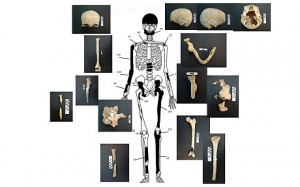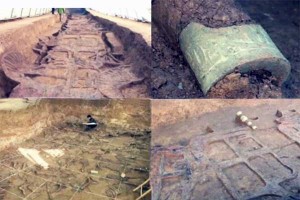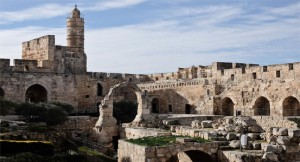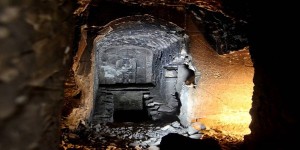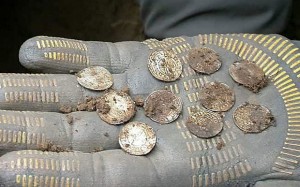Ancient Greek Tomb found with Remains of five People
Archaeologists found a huge tomb built in the time of Alexander the Great in Greece contains the ancient remains of five people. Including a woman aged over 60, a child baby, two men aged between 35 and 45 and another grown person of indeterminate age.
The bones of one of the men bore cut marks which were likely to have come from a sword or a dagger, the Greek civilization ministry said, adding a new twist to the occupants of the graveyard. The fifth person, whose gender and age has not been recognized so far, had been cremated.
Since the tomb was exposed at Amphipolis in northern Greece last year there has been intense theory that it may have been build for Alexander the Great, or failing that one of his generals or his mother. Most experts have discounted the Alexander theory, saying that he was maybe covered in Egypt. The tomb has been dated to between 325 B.C. – two years before the death of the warrior-king – and 300 B.C.
Alexander forged one of the main empires the world had ever seen, a sprawling variety of territories that stretched from the Mediterranean to the Indus. He is supposed to have died in 323 BC, at the age of 32, after an all-night drinking bout in Babylonia, with his body then elated to Alexandria, a city that he founded, for burial. After his death, his generals fought over control of the empire he had recognized.
Throughout those wars, Alexander’s mother, widow, son and half-brother were all murdered – most of them near Amphiboles. Inside the huge tomb – the major ever to have been found in Greece – archaeologists have found two marble statues of sphinxes and a beautiful mosaic pavement which depicts the abduction of Persephone, the daughter of Zeus, by Hades, king of the underworld.
Tests will be conducted on the bones of the woman and two men to decide if they were connected. “Part of the analysis will look into a probable blood relationship … but the lack of teeth and cranial parts that are used in ancient DNA analysis may not allow for a victorious identification,” the culture ministry said.
Chinese archaeologists find 2,800-year old funeral of chariots and horses
A team of Chinese archaeologists has unearthed a set of sophisticated tombs surrounded by 28 chariots and 98 horses in the region of Hubei in China.
The 2,800-year-old group of tombs, which dates back to the spring and Autumn Period (770 BC-476 BC) is situated in the city of Zaoyang, in the province of Hubei. Present explorations have found at least 30 tombs of various sizes.
Preliminary studies show that the tombs belong to high-ranking upper class of the period in Chinese history.
Now a new 33-meter long, four-meter wide chariot pit has been exposed. “This chariot and horse pit is different from those discovered before along the Yangtze River. The chariots and horses were densely buried,” said Liu Xu, professor from School of Archaeology and Museology of Peking University. ” Many of the wheels were taken off and the remaining parts of the chariots were placed one by one.”
At least 28 chariots were found in three months of excavation. About five meters away the chariot pit was a horse pit, where at least 49 pairs of horse skeletons were exposed.
“Judging from the way the horses were hidden, they were buried after they were killed, as there was no outline of struggle. Second, it is the way they were laid. They were laid back to back, lying on their sides. It means that two horses pull one chariot,” said Huang Wenxin, examiner from the provincial archaeological institute.
Liu Xu said the number of chariots and horses stand for the ranks of the deceased.
The number of chariots often established the strength of a country at that time. More chariots mean that the country was powerful. The strength was calculated by the number of chariots. In modern words, the chariots represent a kind of high-tech product. Only people with rather high ranks can own chariots,” Liu said.
The name of the disordered “Spring and Autumn Period” in Chinese history is based on Confucius’ history of the dyna`sty of the time, according to some sources. His book was called “spring and Autumn Annals.
The period was noticeable by the end of feudalism, nascent urbanization and the birth of powerful states formed by the consolidation of smaller principalities, as well as a certain increase in secularism. Among the social changes was the birth of a wealthy merchant class – which may have been among those hidden in the tombs now uncovered.
Why horses were buried with the chariots must stay speculative, but it is known that in ancient China of the time, human and animal sacrifices were made to appease the gods of weather, on whose goodwill mankind depended.
The Chinese were far from alone in enormous ceremonial burials. The ancient Egyptians of the time were also notorious for human give up, burying servants with their departed pharaohs – but that was in a much earlier time, around 3100 BC to 2900 BC, the era of the First Dynasty. After that period, the live retainers were replaced by figurines.
Archaeologists found possible site of Jesus trial in Jerusalem
Archaeologists say they have exposed the remains of King Herod’s palace in Jerusalem and with it the site where the trial of Jesus may have taken place.
The location, near the city’s historic Tower of David, differs from other suggestions for the site of one of history’s most renowned court events, most notably the Antonia Fortress along the pilgrimage route known as the Via Dolorosa, or Way of Sorrows.
The Kishle, an old prison build by the Ottoman Empire nearby to the Tower of David, sat atop ruins of an earlier palace built by Rome’s king of ancient Palestine, Herod, said Amit Re’em, Jerusalem District Archaeologist for the Israel Antiquities Authority, according to the Jerusalem Post.
For two years we excavated this by hand. We dismantled the prison cells but sealed the English, Arabic and Hebrew graffiti that the prisoners had carved,” Re’em told the newspaper.
A police compound neighboring to the Kishle reminds one of the connection of this site; it has been manned by soldiers since the time of the Hasmoneans and before, a considered highpoint chosen by Herod and other kings as a place for a palace and citadel,” the newspaper account said.
Re’em said proof of pools and water conduits — items favored by Herod and noted by historians such as Flavius Josephus — suggest Herod’s palace was here, and that Pilate, who would have been a tourist in Jerusalem at the time of Jesus’ arrest, would have used a space in Herod’s palace for the trial.
We have the retaining walls,” Re’em told the Christian Broadcasting Network last April. “It was an enormous engineering project, and we see it in the excavation. We even found a vast underground sewage that could only belong to the palace of Herod.”
For those Christians who care about truth in regards to historical facts, this is very forceful,” Yisca Harani an expert on Christianity and pilgrimage to the Holy Land told The Washington Post. “For others, however, those who come for the universal mental exercise of being in Jerusalem, they don’t care as long as ends in ‘Golgotha’ — the site of the crucifixion.”
Where trial leading to the crucifixion took place depended on the times in which pilgrim routes were determined, Washington Post reporter Ruth Eglash noted.
In the Byzantine period, for example, the Via Dolorosa began closer to the area where the museum now sits in the western part of the city. It was only after the 13th century that the starting point moved to the Antonia Fortress, the site of a ex- Roman military barracks, which today sits beneath a school close to the al-Aqsa mosque and the golden Dome of the Rock,” Eglash wrote.
Shimon Gibson, an archaeology professor at the University of North Carolina at Charlotte, told Eglash he believes the Kishle may well be the site where Jesus was tried, given the Gospel of John’s report of the trial taking place near a gate on ground with paving stones.
There is, of course, no inscription stating it happened here, but everything — archaeological, historical and gospel accounts — all falls into place and makes sense,” Gibson told the newspaper.
Every year, an expected 1 million Christian pilgrims visit Jerusalem.
Archeologists find out the Mythical Tomb of Osiris, God of the Dead, in Egypt
The incredible discovery was headed by a team of Spanish-Italian archeologists with the help of the Egyptian Ministry of Antiquities. The ancient tomb was found in a large ancient graveyard of Sheikh Abdel-Quma on the West Bank at Thebes. The complex had a shaft that connects to various chambers, including morbid monuments of demons holding knives.
In addition, Egyptologists Milagros Alvarez Sosa of Spain and Irene Morfini of Italy, who found the tomb had also been studying the nearby tomb of Min. The archaeologists said that the neighboring tomb of Osiris was exposed since 1887 but has never been properly examined nor documented. This was because of the lack of technology like colour photography and other modern recording techniques.
According to Gizmodo, the discovery serves as a replica of the Tomb of Osiris and as explained, the tomb features statues of demons holding knives and an emerald-skinned statue of Osiris, which was found sitting in a central arched chapel facing a staircase with a 9-meter shaft in it. It looks more of a maze as the shaft connects to another room with a second shaft that goes down for 19.6 feet or about 6 meters into two rooms.
All the elements of the exposed replica absolutely describe the mythical Osiris tomb. It includes the big 3.5 meters staircase with a four-meter high ceiling at the bottom which leads to the Netherworld and another one which leads openly to Osiris’ statue. The monument is found at a higher level and appears to be alone on this location plus a interment chamber right below the statue.
The myth about Osiris, which is the ancient Egyptian god of the dead and ruler of the underworld, is considered as one of the most famous tales to come out of Egypt. The stories surrounding this figure come in special and complex versions. According to Egyptian Myths, Osiris was also dubbed as the god of Earth and vegetation because after his death a severe lack came to Egypt and his rebirth caused the over-flow of the River Nile which saved men from the deadly drought resulting to the wealth of grain. Based on the myths, Osiris saved Egypt’s culture.
He was also known as the god of immortality as he was supposed to judge the dead and he only allows those who have spent their lives with moral worth to enter afterlife while others were judged to go to the underworld in its place. As mentioned, he was also seen as a god of revival and rebirth and has held different roles according to myths. Osiris was described as a bearded and mummified figure with green skin and one who wears a crown with hands that hold a flail and a crook.
Finally, there is no information on the exact date when the mythical tomb was formed. However, some researchers believe that this precious archaeological find can date back from up to the 25th dynasty or 26th dynasty . The said theory was based on a comparison to similar tombs that also has Osirian elements.
Ancient Coins Worth £1 Million Found buried in farmer’s field
A hoard of rare Anglo Saxon coins value more than £1 million has been found in a farmer’s field by amateur treasure hunters.The stunning detection is one of the most important finds in Britain in recent years.
The coins – over 1,000 years old – were unearthed during a Christmas dig controlled by the Weekend Wanderers Detecting Club in rural farmland near Aylesbury, Bucks.Over 100 people turned out to take part in the festive hunt and they were amazed to find the collection of more than 5,000 silver coins.
The perfectly sealed pieces, which mark the faces of Anglo Saxon kings, were in a lead bucket which was hidden two feet underground.
Experts said the really rare coins could be worth more than £1 million and club leader Pete Welch said the find was ‘very significant’.
‘They’re like mirrors, no scratching, and buried in fact carefully in a lead container, deep down. Pete, said
‘It looks like only two people have handled these coins. The person who made them and the person who covered them.
‘Metal detecting is a bit casual but most farms have a bit of history so you have a chance of finding something.
‘I think this was a case of you either move to the right or move to the left and on this holder our member moved the right way.
‘I’m just hoping that these coins will end up in a museum for the public to see. I wouldn’t want to see them go to a private collector.’
The discovery of a entire of 5,251 coins was made during the annual dig on December 21 on rural farmland the group had visited before.After they were found archaeologist Ros Tyrrell was called to help dig them.
The coins are in ‘excellent condition’ and show the faces of some of the kings of England dating back 1,000 years.
They contain coins from the reigns of Ethelred the Unready (978-1016 AD) and Canute, or Cnut.
Mr Welch believes the hoard is equal in significance to the Staffordshire Hoard of gold and garnets found by a metal detectorist in 2009.He added: ‘We don’t know how many variations of the coins there are and when we do we will know how significant the find is.
This would have been a vast amount of money in its day. One coin alone would have been a lot back then.
A Bucks County Museum spokesman said: ‘This is one of the largest hoards of Anglo Saxon coins ever found in Britain.
‘When the coins have been correctly identified and dated, we may be able to guess at why such a huge treasure was hidden.’
He added that as the coins are valuable metal over 300 years old they fall within the remit of the Treasure Act.
They will now be taken to the British Museum for protection and classification before a coroner will decide whether they are legally treasure.
A museum will then be able to bid for the coins with the money from the sale being split between the land owner and the person who made the discovery.
